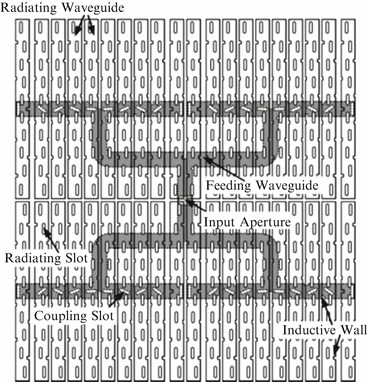Slot Waveguide Design
Modes of Slot Waveguides
Silicon Slot Waveguide
Simulation of silicon cross-slot waveguide with FIMMWAVE software
FIMMWAVE's mode solvers were used to calculate the modes of a silicon cross-slot waveguide; slot waveguides use a combination of high-index and low-index layers to generate light confinement.
FIMMWAVE can be used to model any slot waveguide geometry built from any materials, including silicon, polymer and hybrid slot waveguides. The silicon cross-slot waveguide presented here is taken from an article from Helsinki University of Technology [1], featuring FIMMWAVE simulations. The paper also presents results for waveguide geometries with angled sidewalls.

See also [2], also featuring FIMMWAVE simulations for the modelling of slot waveguides.

An optimal design of a slot waveguide is presented for realizing an ultrafast optical modulator based on a 220 nm silicon wafer technology. The recipe is to maximize the confinement and interaction between optical power supported by the waveguide and electric field applied through metallic electrodes.
- If the waveguide slot antenna is designed in this manner, then all of the slots can be viewed as being in parallel. Hence, the input admittance and input impedance for an N element slotted array can be quickly calculated: The input impedance of the waveguide is a function of the slot impedance.
- Waveguide slot arrays are widely used in radar and telecommunication applications, especially where high gain, increased power-handling capacity and compact dimensions are critical.
- Key words: array antennas, edge-slotted waveguide, slot arrays, waveguide antennas, resonant shunt slots. ABSTRACT This paper presents the design, fabrication, and operation of an edge-wall slotted waveguide array antenna with metal flare for the generation of ultralow side lobes fan-beam radiation. The single traveling wave array antenna.
Slot Waveguide Design Machine
Silicon slot waveguide designed in FIMMWAVE
The modes of the silicon slot waveguide were calculated using FIMMWAVE's fully vectorial FDM Solver. The calculation only took a few seconds, and the solver was able to take advantage of the waveguide symmetry.
This waveguide is a single-mode waveguide, and the fundamental TE-like mode and TM-like mode are shown below. You can see clearly how the cross-slot geometry generates a 90-degree rotation of the field distribution between the two polarisations. FIMMWAVE can also provide a large number of mode properties, including effective index, propagation constant, group index, dispersion, polarisation, effective mode area, confinement factor etc.
Properties of the fundamental TE-like mode of the silicon cross-slot waveguide:
(clockwise from top-left) intensity profile, Ex field profile and horizontal section, mode properties

Properties of the fundamental TM-like mode of the silicon cross-slot waveguide:
(clockwise from top-left) intensity profile, Ey field profile and horizontal section, mode properties
Slot Waveguide Design Definition
FIMMWAVE allows you to check the accuracy of your calculation as it features three independent fully-vectorial Cartesian mode solvers: the FMM, FDM and FEM Solvers. We ran the simulation with all three solvers and found the results to be in excellent agreement.
FIMMPROP, the propagation tool associated with FIMMWAVE, can also be used to model light propagating within slot-waveguide structures.
References
Coplanar Waveguide Design
[1] A. Khanna, A. Säynätjoki, A. Tervonen and S. Honkanen, 'Control of optical mode properties in cross-slot waveguides', Applied Optics 48, 34, pp. 6547-6552 (2009)
[2] M.P. Hiscocks, C. Su, B. Gibson, A.D. Greentree, L.C.L. Hollenberg, and F. Ladouceur, 'Slot-waveguide cavities for optical quantum information applications', Optics Express 17, 9, p7295-7303 (2009)
More publications
Acoustic Waveguide Design

Click here to find publications that include FIMMWAVE simulations of slot waveguides on Google Scholar.